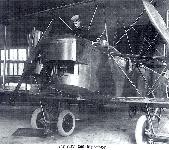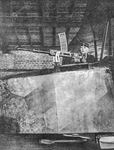
Описание
Страна: Германия
Год: 1918
Варианты
- AEG - G.I/G.II/G.III - 1915 - Германия
- AEG - G.IV - 1916 - Германия
- AEG - G.IVk - 1918 - Германия
- O.Thetford, P.Gray German Aircraft of the First World War (Putnam)
- J.Herris AEG Aircraft of WWI (A Centennial Perspective on Great War Airplanes 16)
- M.Dusing German Aviation Industry in WWI. Volume 1 (A Centennial Perspective on Great War Airplanes 84)
-
J.Herris - AEG Aircraft of WWI /Centennial Perspective/ (16)
AEG G.IVk G.500/18
-
J.Herris - AEG Aircraft of WWI /Centennial Perspective/ (16)
AEG G.IVk G.501/18
-
J.Herris - AEG Aircraft of WWI /Centennial Perspective/ (16)
AEG G.IVk G.503/18
-
J.Herris - AEG Aircraft of WWI /Centennial Perspective/ (16)
The AEG G.IVk, the 'k' suffix for 'Kanon', was an armored development of the G.IV for antitank duties. The cockpits and both engines were armored against rifle and machine-gun fire to survive at low altitude while hunting tanks. The front and rear gunners each had a flexible 20mm Becker cannon that could fire downward at ground targets plus an upward-firing machine gun to defend against fighter attacks. A 'box' tail with twin fins and rudders was fitted to improve control in case of an engine failure. Five of these were turned over as part of the armistice terms; it is not known if they arrived in time for combat operations.
-
M.Dusing - German Aviation Industry in WWI. Volume 1 /Centennial Perspective/ (84)
The prototype AEG G.IVk was G.500/18 shown here on the AEG factory airfield at Henningsdorf. The four production aircraft had a different tail design. G.500/18 wears an interesting camouflage of two-color sprayed camouflage on the fuselage, dark engine nacelles, and printed camouflage fabric on the fins and rudders. The 20mm Becker cannon in the nose mounting is prominent. This aircraft was dispatched to the front for operational use in October-November 1918, but it is not known if it was used in combat.
-
Сайт - Pilots-and-planes /WWW/
AEG G-IVk 500/18 prototype.
-
Сайт - Pilots-and-planes /WWW/
AEG G.IVk 503/18 (1918)
-
J.Herris - AEG Aircraft of WWI /Centennial Perspective/ (16)
The AEG G.IVk G.503/18 was one of the four production G.IVk ground-attack aircraft turned over to the British according to the terms of the armistice. The vertical tail surfaces of the four production machines differed from the prototype. The aft gunner could fire his 20mm Becker cannon conventionally to the sides or down through the fuselage in a Gotha-like tunnel, and could do the same with his machine gun.The forward gunner had a forward-firing 20mm Becker cannon for anti-tank duties and a flexible machine gun to defend against fighter attack. No conventional bomb bay was fitted but the AEG G.IVk had four vertical tubes about two feet long mounted in the front cockpit and three in the rear cockpit. These tubes were perhaps intended for launching flares or special anti-tank bombs that Idflieg had developed.
-
J.Herris - AEG Aircraft of WWI /Centennial Perspective/ (16)
Four production AEG G.IVk ground-attack aircraft, G.501/18 - G.504/18, were turned over to the British as part of the armistice terms; G.503/18 appears to the aircraft shown here.
-
J.Herris - AEG Aircraft of WWI /Centennial Perspective/ (16)
The rear gunner of the AEG G.IVk in his turret handling his 20mm Becker cannon. Although no bomb bay was fitted and supposedly no bomb racks, bombs can be seen underneath his position. He could fire both his cannon and machine gun to the sides and downward through a Gotha-style tunnel through the fuselage.
-
J.Herris - AEG Aircraft of WWI /Centennial Perspective/ (16)
The nose turret of the AEG G.IVk with the 20mm Becker cannon seen from the inside. Although the cannon pointed forward and down for ground-attack, the gunner's machine gun was in a conventional gun ring to defend against fighters.
-
J.Herris - AEG Aircraft of WWI /Centennial Perspective/ (16)
The nose turret of the AEG G.IVk showing the 20mm Becker cannon. Armored doors to close the mounting are at the sides of the opening for the cannon.
-
J.Herris - AEG Aircraft of WWI /Centennial Perspective/ (16)
An Australian soldier pokes his head our of the nose turret of the AEG G.IVk; another stands in the cockpit. The armor plate was difficult to form, so all armor on the aircraft was either a flat plate or a simple curve. Compound curves were simply too difficult to form at the time.
-
Сайт - Pilots-and-planes /WWW/
Tightly squeezed into an experimental turret, the gunner demonstrates the operation of a 2 cm Becker cannon mounted in the AEG G.IV 1096/16 bomber. Effective firing trials against ground targets were performed in October-November 1917. The turret was capable of rotation. The curious, heart-shaped machine gun support on the upper turret is likewise an experimental installation.
O.Thetford, P.Gray German Aircraft of the First World War (Putnam)
A.E.G. G IVk
Yet another variant of the G IV. Fitted with 2 cm. Becker Cannon in an armoured nose panel, and intended for use with the Schlachtgeschwadern in 1918, it is not thought to have been used operationally. A biplane tail unit was fitted and armour plate panels also enclosed the 260 h.p. Mercedes D IVa engines. Standard G IV wing cellule of 18.4 m. (60 ft. 44 in.) was fitted. A second version with G V wing cellule (G IVk 503/18) also existed.
Описание:




















